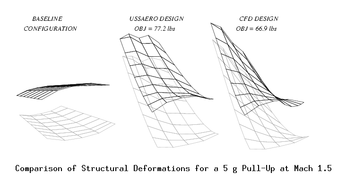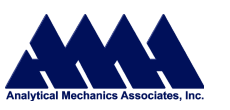Successful design of aerospace vehicles must incorporate
knowledge from various engineering disciplines, such as
structures, propulsion, aerodynamics, heat transfer, and controls.
In the last fifteen years true multidisciplinary design
(not simply the analysis of a given design from the perspective
of any given engineering discipline) has become possible
due to the emergence of new tools.
One such tool for the
preliminary design of aerospace structures is the Automated
Structural Optimization System (ASTROS).
As with many structural optimization programs, the aerodynamic
modeling capabilities within ASTROS are based on linear
panel methods and, thus, have a limited range of applicability.
With the expanded flight envelopes being considered for maneuvering
aircraft, it has become increasingly important to be able
to model nonlinear steady and unsteady aerodynamics earlier
in the design cycle.
Including Computational Fluid Dynamics (CFD)
models within ASTROS has the potential
of extending significantly its range of applicability, flow conditions,
and geometry capabilities.
In doing so, adverse fluid-structure
interactions can be detected early in the design cycle.
Click on Figure for more pictures
 The objective of this study was to demonstrate the feasibility of
integrating modern CFD aerodynamic prediction technology in ASTROS.
A detailed analysis was carried out, presenting how to make use of
both steady and unsteady CFD-generated air loads in the design
disciplines of ASTROS.
Both NASA's Direct Iterative Surface
Curvature (DISC) method and CFD automatic differentiation (ADIFOR)
were evaluated to compute sensitivities to geometric design variables
and formulate alternative Aerodynamic Influence Coefficient (AIC)
matrices.
A demonstration of a Computational Fluid Interface (CFI)
was carried out by coupling ASTROS with NASA's transonic small disturbance
computational aeroelasticity program CAPTSD.
This demonstration
involved the redesign of a composite wing under transonic and supersonic load
conditions, subject to static aeroelastic constraints (see Figure).
Finally, detailed
plans were drawn to minimize the number of CFD runs required, since
the overall computational cost is dominated by CFD.
Unique solutions
maximizing the use that can be made of each CFD run were developed,
both to carry out nonlinear trim module enhancements and for the
inclusion of unsteady aerodynamics.
The objective of this study was to demonstrate the feasibility of
integrating modern CFD aerodynamic prediction technology in ASTROS.
A detailed analysis was carried out, presenting how to make use of
both steady and unsteady CFD-generated air loads in the design
disciplines of ASTROS.
Both NASA's Direct Iterative Surface
Curvature (DISC) method and CFD automatic differentiation (ADIFOR)
were evaluated to compute sensitivities to geometric design variables
and formulate alternative Aerodynamic Influence Coefficient (AIC)
matrices.
A demonstration of a Computational Fluid Interface (CFI)
was carried out by coupling ASTROS with NASA's transonic small disturbance
computational aeroelasticity program CAPTSD.
This demonstration
involved the redesign of a composite wing under transonic and supersonic load
conditions, subject to static aeroelastic constraints (see Figure).
Finally, detailed
plans were drawn to minimize the number of CFD runs required, since
the overall computational cost is dominated by CFD.
Unique solutions
maximizing the use that can be made of each CFD run were developed,
both to carry out nonlinear trim module enhancements and for the
inclusion of unsteady aerodynamics.
Commercial Applications:
The ability to accurately and efficiently
incorporate CFD-generated aerodynamics into the multidisciplinary
design capabilities of ASTROS is a significant leap in the design process,
particularly for transonic flow and high angle of attack conditions.
The benefits of this early multidisciplinary integration are: reduced
design cycle time and reduced time-to-market for airframe manufacturers.
References:
Reisenthel, P. H.,
"
Novel Concepts for a CFD-Enhanced ASTROS Capability."
NEAR TR 510, Nielsen Engineering & Research,
Mountain View, CA, April 1996.





